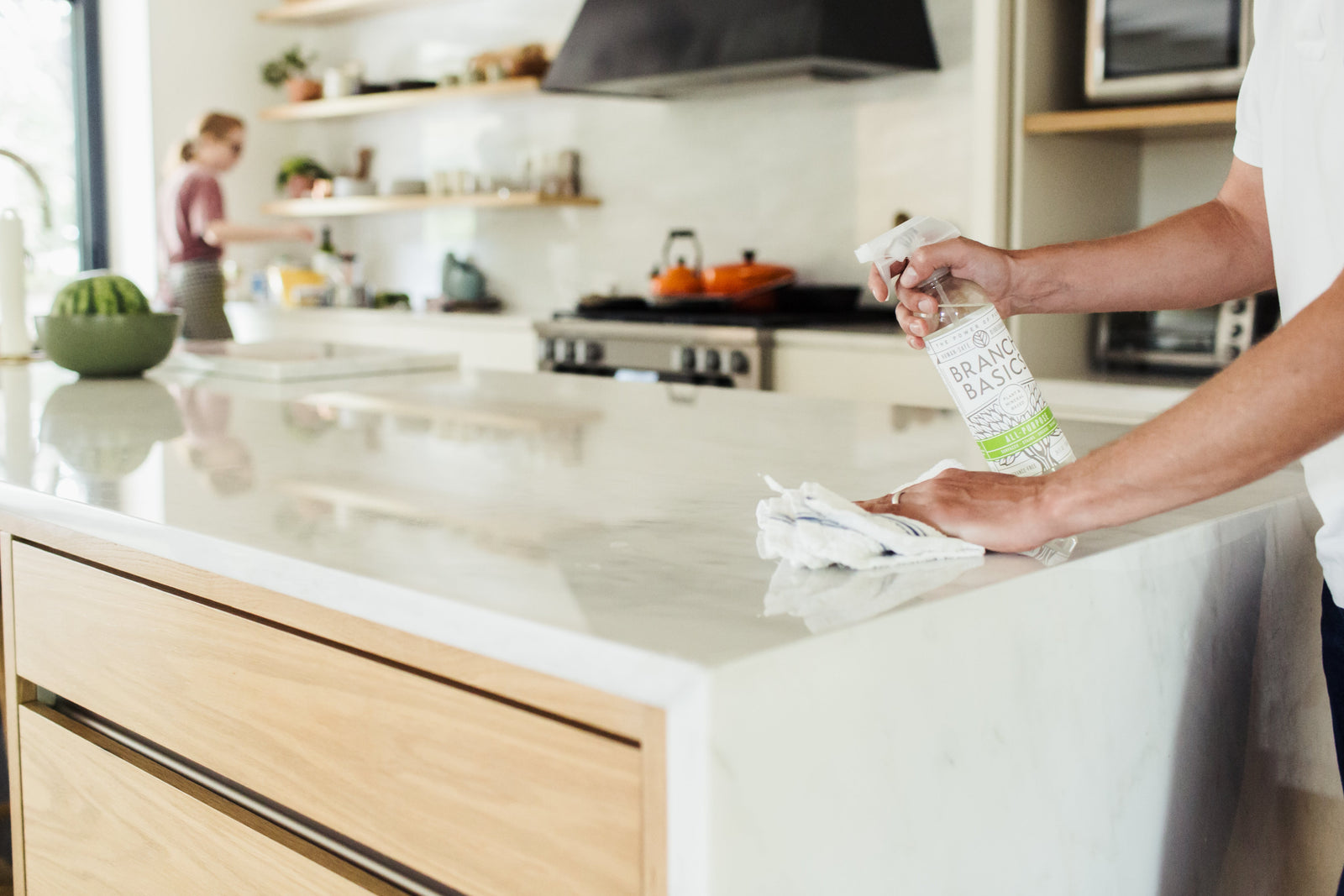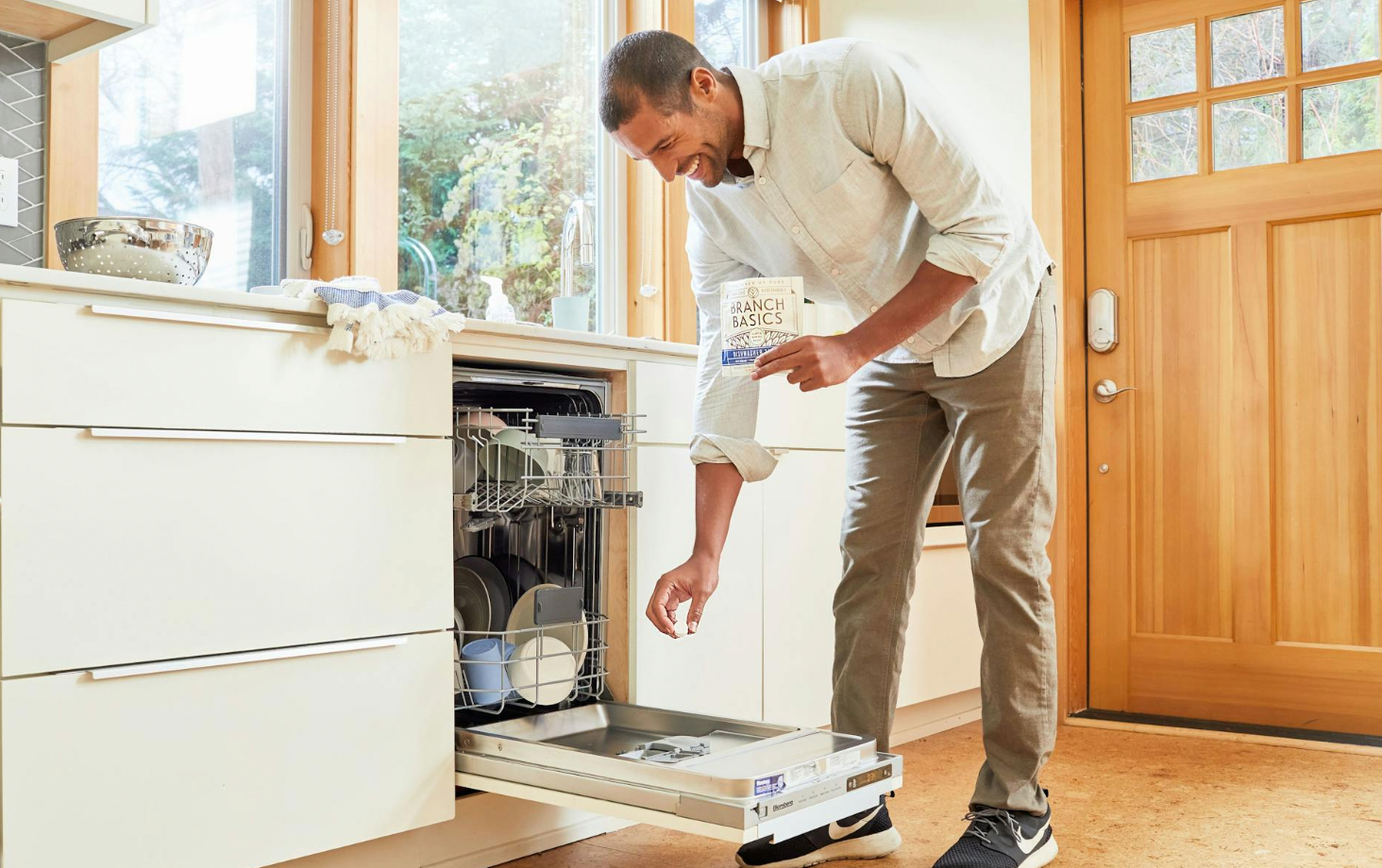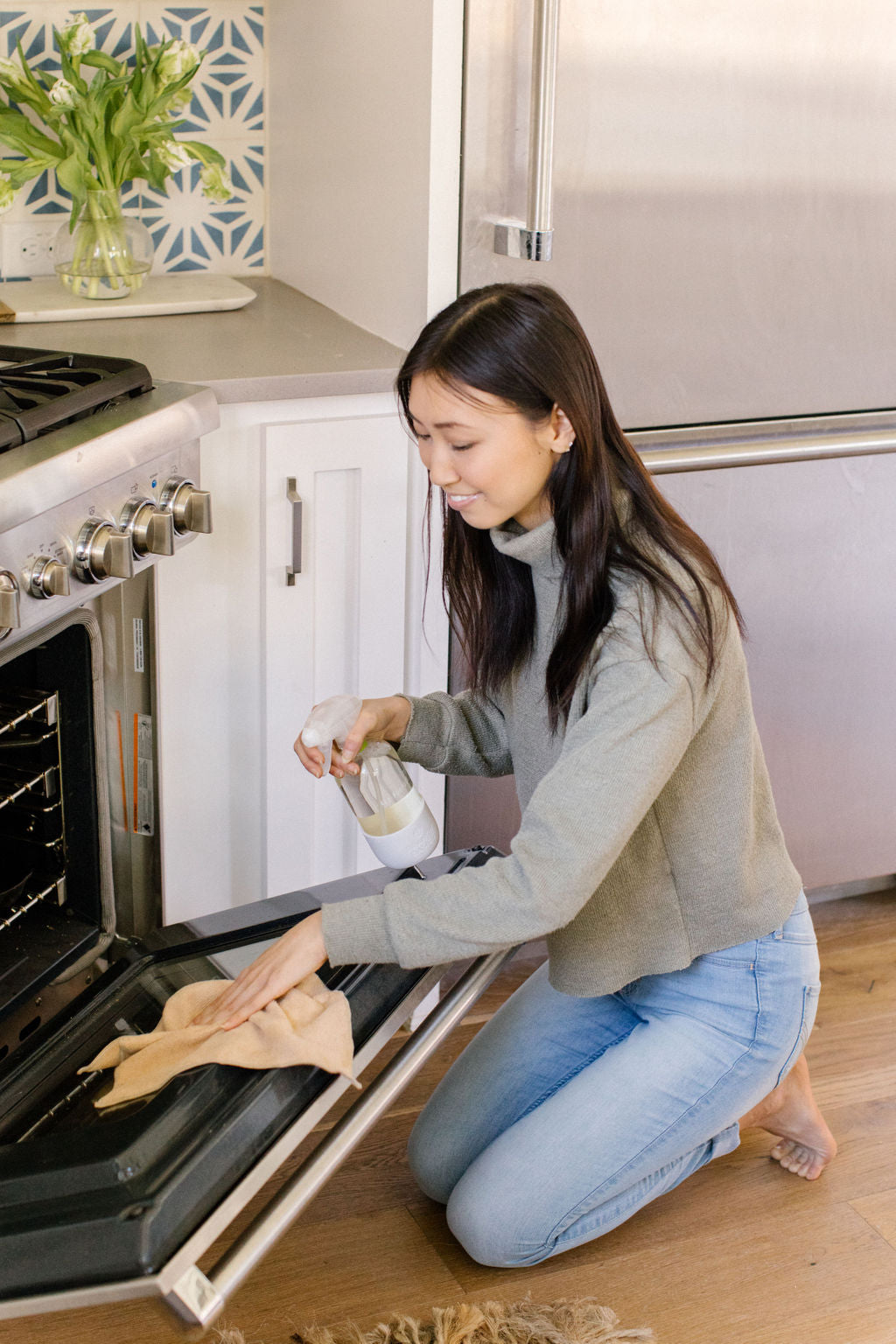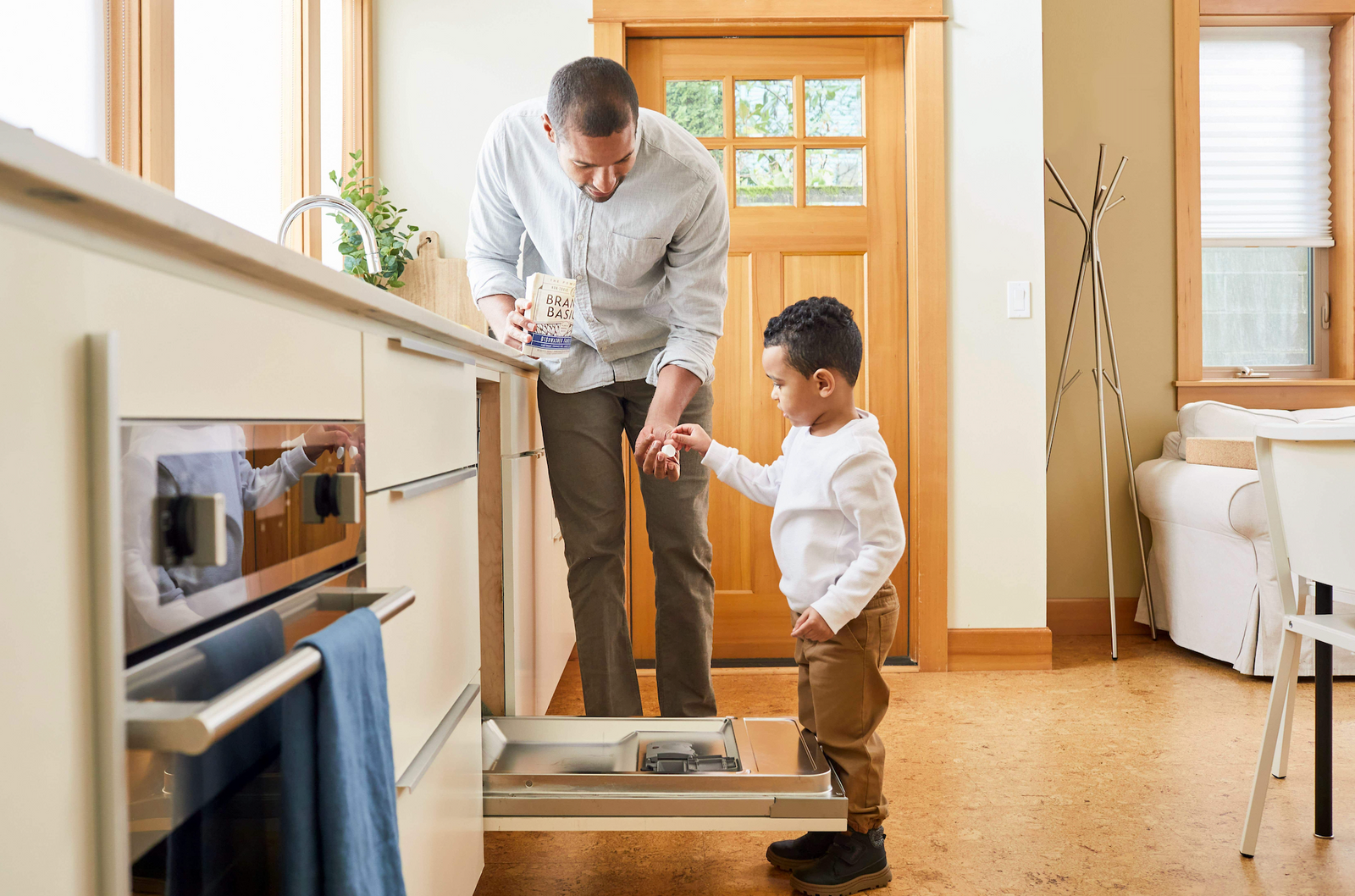The Most Effective Kitchen Cleaners Without Bleach

Kitchens can be a hot-spot for germs, dirt, grime, grease, and even disease-causing bacteria.
This is why many people rely on bleach to clean and disinfect their kitchens.
However, using bleach has some serious drawbacks.
If this makes you second-guess using bleach-based cleaners in your home’s main food-production area, this article is for you.
Here, we’ll discuss the best kitchen cleaners without bleach that cut through kitchen grime and disinfect or remove germs safely and effectively.
Why You Should Avoid Bleach in the Kitchen
Bleach should be avoided in the kitchen and anywhere in a healthy home because it is a toxic, poisonous, and hazardous chemical.
Yes, most of us grew up in households that used bleach for cleaning, laundry, and disinfecting.
But that doesn’t mean it is (or ever was) safe.
So, how harmful is ordinary household bleach?
Let’s look at some science-backed facts about bleach:
- Bleach is an EPA-registered pesticide and hazardous substance.
- Passive exposure to bleach in the home has been shown to cause an increased risk of respiratory illness and other illnesses in children.
- Fumes from bleach, such as chloroforms and nitrogen trichloride, can cause DNA damage, cancer, asthma, and a host of other illnesses.
- Exposure and passive exposure to bleach can increase your risk of lung disease, including asthma and COPD.
- It is corrosive to skin and eyes and can cause severe burns.
- Bleach creates a chloramine gas when combined with other chemicals or organic matter. This gas is highly irritating and corrosive to the skin, lungs, and eyes.
- Water treated with sodium hypochlorite (and its cousins) has been shown to release chloroform gas when mixed with organic matter, such as urine or dirt. A Taiwanese study showed an increased cancer risk in those who showered in highly chlorinated water.
- Bleach can encourage the growth of mold and mildew. It does kill surface mold. However, it does not kill mold beneath the surface and introduces water to the invisible mold, allowing it to thrive. Hence why the EPA and OSHA no longer recommend bleach for mold remediation.
In addition to exposure from cleaning or laundry, bleach fumes can accumulate and linger on surfaces and in the air and seep out of sealed bottles (think about what you smelled the last time you were in the laundry aisle at the grocery store).
This means you’re not just exposed while actively using bleach but all day and night so long as bleach remains in your home.
Our goal is to empower you with the facts so you can create a healthier home and take charge of your health.
Learn more in: Is Sodium Hypochlorite (Bleach) Toxic?
The Best Kitchen Cleaners Without Bleach
When searching for kitchen cleaners without bleach, you want to look for products or product combinations that will power through kitchen messes and remove germs or disinfect surfaces.
We’re not big fans of over-sanitizing and usually prefer to remove germs versus kill them (you can read more here).
However, there is a time and a place for disinfecting, such as after handling meat, poultry, or fish on surfaces.
Here, we offer several human-safe DIY options for cleaning and disinfecting without bleach.
DIY All Purpose Kitchen Cleaners
These All-Purpose, human-safe kitchen cleaners can be whipped up in seconds and used on sinks, surfaces, cook tops, garbage cans, dishes, and more.
1. Branch Basics All-Purpose
Branch Basics Concentrate was designed as a one-bottle, human-safe solution to replace every household cleaner in your home.
Just add water to create All-Purpose, Bathroom, Streak-Free, Foaming Wash, Laundry, Floor Cleaner, and more.
For kitchens, All-Purpose dilution works on surfaces, sinks, handwashing dishes (Bathroom and Concentrate dilutions work well, too), ovens, cook tops, cutting boards, counter tops, as a produce wash, floor cleaner, and more.
Note: Branch Basics is a natural soap that will effectively remove germs but not kill them. If desired, it can be used with a natural disinfectant (which we’ll discuss coming up).
2. Vinegar and Water
A 50:50 mixture of distilled white vinegar with water makes an excellent all-purpose, bleach-free kitchen cleaner.
Vinegar contains natural acetic acid, which is tough enough to dissolve dirt, grime, and eliminate certain germs such as:
- E. Coli
- Salmonella
- Listeria monocytogenes
This combination works on surfaces, sinks, cooktops, stainless steel, certain types of flooring, garbage cans, cutting boards, and more.
Undiluted vinegar can also be used as a descaling agent in coffee makers, dishwashers, tea kettles, and other appliances.
Note: Vinegar has acetic acid, a lung irritant when sprayed. Use in a ventilated area and make a conscious effort not to inhale the freshly sprayed vinegar. Do not spray vinegar in the presence of children, older people, and those with lung or chronic health conditions.
Learn more in: 12 Ways To Use Vinegar In Your Home.
3. Lemon Juice and Water
Lemon juice contains natural antimicrobial acids and enzymes, making it an effective bleach alternative for some kitchen surfaces, sinks, certain types of flooring, and more.
Use a 50:50 blend of lemon juice and water to create an all-purpose cleaner for your kitchen.
This cleaner can also be used on certain types of tile floors.
*Note: Acidic cleaners, such as lemon juice, may not be suitable for concrete, natural stone, marble, unglazed quarry stone, and some sealers. Check with the manufacturer.
4. DIY Castile Soap All-Purpose Cleaner
Pure castile soap can be combined with other ingredients, such as lemon juice, vinegar, water, and/or baking soda, to create an effective multi-purpose kitchen cleaner.
There are many DIY castile soap recipes to choose from. Just make sure the ingredients are non-toxic, and that you’re using pure unscented castile soap.
Here are a few safe options:
- Vermont Castile Soap
- Natural Way Organic Castile Soap
- St. Clare Castile Soap
- Carolina Castile Soap
- Cove Castile Soap
Here’s a basic all purpose castile soap recipe:
- 1 cup distilled white vinegar or lemon juice
- 1 tablespoon unscented, liquid castile soap (see safe options above)
- 1/2 to 1 cup water (depending on the strength you want)
- 10-20 drops pure essential oils (if desired)
Mix everything in a spray bottle (use glass or stainless steel if using essential oils), and use it as an all-purpose cleaner.
Glass & Stainless Steel Cleaners
For a streak-free shine, try these bleach-free, human-safe glass and stainless steel cleaners.
1. Branch Basics Streak Free or All-Purpose
Branch Basics Streak Free dilution is so simple and cost-effective to make, it’s hard to believe it works so well.
Simply fill the Streak Free bottle with water, and add 1 drop (yes, 1 drop!) of Branch Basics Concentrate.
Spray directly on stainless steel and wipe with a microfiber cloth.
That’s it!
This magical, ultra-gentle, human-safe cleaner can be used on any glass surface and works wonders on stainless steel.
All-Purpose also works well on stainless steel countertops. Do a small patch-test to determine which dilution works best for your kitchen-cleaning needs.
2. Vinegar and Water
That same 50:50 vinegar and water solution can also be used on glass and stainless steel.
Just spray directly on stainless steel surfaces, and wipe with a microfiber cloth.
Degreasers
For kitchen messes that call for serious degreasing, try these DIY bleach-free alternatives.
1. Branch Basics
Branch Basics All-Purpose or Bathroom dilution (for tougher jobs) are excellent degreasers for kitchen surfaces, ovens, and dishes.
- For surfaces, spray on and wipe clean with a microfiber cloth.
- For dishes, spray All-Purpose or Bathroom directly onto the dishes or into a basin of dish water. Wash and dry.
- For oven-cleaning instructions, click here.
2. Vinegar or Lemon Juice
Vinegar and lemon juice are natural degreasers that can be used on most surfaces.
For everyday degreasing, the all purpose DIY vinegar or lemon juice cleaners shared above should do the trick.
Just spray on, let dwell a few minutes, and wipe clean.
For really big messes, try using undiluted vinegar or lemon juice.
3. Baking Soda
Baking soda is a wonderful degreaser for oven cleaning.
To use, make a thick paste with water and scrub onto your oven to remove grease and grime.
Follow up by spraying undiluted distilled white vinegar to create a natural foam.
Let dwell 10-30 minutes depending on soil level, and wipe clean.
DIY Baking soda/castile soap mixtures also work well to degrease and clean ovens and stovetops.
Learn more in 12 Uses for Sodium Bicarbonate.
4. Castile Soap or Natural Dish Soap DIY Cleaners
Oil-based soaps, such as liquid castile soap or natural dish soaps, are excellent degreasers.
You can either use them undiluted to spot-clean, or use that same all-purpose recipe given above using either liquid castile soap or natural dish soap.
If you find you need more degreasing power, add an extra tablespoon of unscented castile soap to the DIY recipe.
Note: Dish soaps and detergents contain some of the most potentially harmful and caustic chemicals on the market and should be avoided (especially in homes with children or babies).
When buying dish soap, avoid products containing:
- Cocamidopropyl Betaine
- Dipropylene Glycol
- DMDM Hydantoin (Quaternium-15)
- Fragrance
- Dioxins from PEGs, Polyethylene Glycol, and chemicals ending with “eth”
- Polysorbates
- Preservatives and antimicrobials such as Methylchloroisothiazolinone and Benzisothiazolinone
- Synthetic Dyes
- Synthetic surfactants such as Sodium Lauryl Sulfate & Sodium Laureth Sulfate
Some of our favorite safe and natural dish soap products are:
- Branch Basics Concentrate or Bathroom
- Fragrance-Free AspenClean
- Fragrance-Free Attitude
You can also take advantage of our easy vetting system and use EWG Skin Deep to ensure all product ingredients are safe.
Human-Safe Kitchen Disinfectant Without Bleach
There is a time and a place for disinfectants in the kitchen and around the home.
The problem is most of us have been taught to over-sanitize, which can lead to the proliferation of superbugs and even disrupt our microbiomes.
However, if you’re working with raw meats, poultry, or fish or cleaning up after someone who is ill, using a safer disinfectant like hydrogen peroxide and distilled white vinegar (used separately and stored in separate bottles) on frequently touched surfaces is recommended.
Here’s how to use this powerful combination to disinfect surfaces safely and effectively.
Materials needed:
- Branch Basics All-Purpose, or another DIY all-purpose cleaner
- Split fiber Microfiber
- Distilled White Vinegar (5% acidity) and/or Hydrogen Peroxide (3% solution–brown bottle)
- A spray nozzle for the brown bottle of peroxide. Exposure to light breaks down hydrogen peroxide so the brown bottle protects it.
- A spray bottle for the vinegar (or a spray nozzle for the bottle if it will fit)
Process
- Always clean the surface first with a microfiber and Branch Basics or another DIY all-purpose cleaner to remove dirt, grease, grime, and germs before using hydrogen peroxide or a combination of hydrogen peroxide and vinegar.
- Rinse with hot water—especially if the surface is a cutting board. Just these first two steps can completely remove germs, but if there is still concern on cutting boards or other surfaces, continue to step 3.
- Spray the surface with hydrogen peroxide. Let it sit for 5-10 minutes.
- If you decide to use both the vinegar and hydrogen peroxide they must be in separate bottles—do not combine.
- Next, spray the surface with the vinegar. After spraying, let it sit for 5 minutes (dwell time), then wipe with a microfiber.
That’s it.
Learn more, including when disinfecting is appropriate, in:
3 Tips For A Clean, Human-Safe Kitchen
The kitchen is the heart of the home, where we gather, get creative, and nourish ourselves and our families.
It’s also one of the most important places to keep clean and avoid using synthetic chemicals that could contaminate food and drink.
As you’ve learned so far, having a clean and sanitized kitchen is entirely possible without using synthetic chemical cleaners.
Let’s look at some other ways you can keep and create a cleaner, human-safe kitchen.
1. Toss The Toxins
Eliminating bleach-based and other synthetic chemical kitchen cleaners is a tremendous start in creating a healthier cooking environment.
However, there are other toxins lurking in various places around the kitchen.
Some examples include:
- Non-stick cookware
- Plastic storage containers
- Dish soap and detergents
- Cutting boards
- Coffee makers
- And (of course) the food we eat
If you’re interested in learning more about detoxifying your kitchen and home, click the links above and check out our Toss The Toxins Online Course.
Here, the founders of Branch Basics guide you through a 12+ video series broken down by categories to help you remove harmful products and drastically improve the air quality in your home. All at your own pace!
2. Clean Your Refrigerator Regularly
Refrigerators can harbor harmful mold, bacteria, and odors if not cleaned regularly.
To clean your fridge’s shelving, walls, and crispers, wipe them clean with the All Purpose cleaner.
For stuck-on food, allow dwell time of 3-5 minutes and add some Oxygen Boost for a gentle abrasive.
Bonus tip: line your crisper drawers once a week with fresh natural paper towels to absorb moisture and odors and prevent stains.
We like to do a wipe-down of our fridges and toss any old food or leftovers (which we are mindful to keep to a minimum) the day or night before we do our weekly grocery shopping.
Sure, it doesn’t happen every week, but this type of regular cleaning reduces the need for deep-cleaning later on.
3. Practice Proper Food Storage
No one likes to see spoiled food.
Unfortunately, few of us have been taught how to properly store food.
We discuss this at-length in: How To Keep Produce Fresh Longer and Switching To Glass: The Best Way To Avoid Phthalate And BPA Exposure.
Here are a few tips from those articles:
- Meal plan to reduce food waste and grocery bills.
- Bring your own cloth bags for produce instead of using plastic bags.
- Use an inexpensive fridge thermometer to ensure your fridge temperature stays between 34 and 40 degrees Fahrenheit.
- Line crisper drawers with non-toxic paper towels to keep veggies fresh.
- Use glass storage containers as much as possible to reduce exposure to plastic chemicals, which leach into produce and other foods.
We offer dozens of other tips for extending the life of fruits and veggies and food storage in the full articles.
Create A Bleach-Free Home With Branch Basics
Isn’t it a relief to know you can have a completely clean and sanitized kitchen without resorting to bleach-based cleaners?
Human-safe cleaning isn’t complicated when you know the right product or tool for the job.
We encourage you to explore our site to learn more about human-safe cleaning, tossing the toxins, and creating a healthier home.
Interested in trying Branch Basics for your kitchen?
Check out our Starter Kits, available in plastic or glass. Or test out a trial-size Branch Basics Concentrate and All-Purpose bottle with our $5.00 trial kit.
Kitchen Cleaner FAQs
Now that you know how to clean your kitchen without bleach, let’s address some FAQs.
Q: How Often Should I Clean My Kitchen Using These Bleach-Free Alternatives?
Kitchens should be cleaned up after every meal and deep-cleaned as needed, typically once per week for families.
We recommend cleaning kitchen sinks every night after dinner or immediately after handling meat, poultry, fish, etc., as they are one of the home's germiest places.
Cooktops and stoves should also be cleaned at least once a day to prevent build-up and staining, and countertops should be wiped down after any meal or food prep.
Dishwashers should also be cleaned regularly to maximize efficiency and extend their life.
Ovens can be cleaned as needed, but don’t wait until they start smoking to do it! The longer the oven bakes-on food, grease, and grime the harder it is to remove.
For more kitchen cleaning tips, see our User Guide.
Q: Do Bleach-Free Cleaners Kill Bacteria As Effectively As Bleach?
Great question.
As addressed previously, products like distilled white vinegar and hydrogen peroxide can be used to kill certain germs.
However, when used together, as outlined in the disinfecting section, they will work as well as bleach to disinfect your kitchen.
Q: Are There Any Surfaces I Should Avoid Using These Bleach-Free Alternatives?
Yes.
Some surfaces, such as concrete, natural stone, marble, unglazed quarry stone, and some sealers, may not be compatible with vinegar or lemon juice.
Also, the optimal Branch Basics dilution to use on floors depends on your flooring.
We offer tips and advice in: How To Clean Floors With Branch Basics.
Always check with the manufacturer for their recommendations.

Marilee Nelson
Marilee Nelson is an Environmental Toxins expert who has spent nearly 30 years advocating for the chemically-sensitive and chronically-ill. She is a Board Certified Nutritionist, Certified Bau-Biologist and Bau-Biology Inspector and specializes in Food As Medicine. She has helped thousands of families and individuals identify, heal and recover from toxic exposures and is on a mission to revolutionize the way American families view their health.








